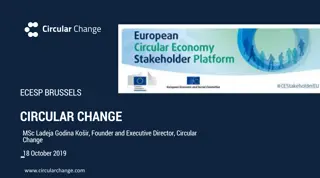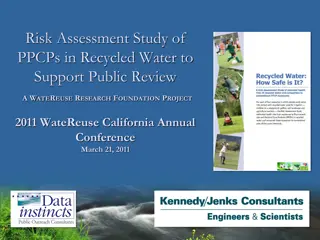Understanding Recycled Copper Use in the Circular Economy
Explore the drivers and barriers of recycled copper use in the context of the circular economy. Antitrust guidelines for copper industry trade meetings and insights on scrap copper use are discussed. Cost, ESG pressure, and market dynamics impact the current and future utilization of scrap copper. While cost is a key driver, barriers such as demand for high-purity semiconductors constrain the full potential of copper recycling.
Download Presentation

Please find below an Image/Link to download the presentation.
The content on the website is provided AS IS for your information and personal use only. It may not be sold, licensed, or shared on other websites without obtaining consent from the author. Download presentation by click this link. If you encounter any issues during the download, it is possible that the publisher has removed the file from their server.
E N D
Presentation Transcript
Recycled Copper Use and the Circular Economy: Drivers and Barriers
Antitrust Guidelines for Copper Industry Trade Association Meetings The following guidelines with respect to compliance with antitrust laws of the United States, Japan and European Community1are intended to govern the conduct of participants in copper industry trade association meetings, both at the meeting itself and in informal discussions before or after the formal meeting. Price: Competitors should not discuss future prices (including terms of sale) of their products. There is no blanket prohibition against the mention of or reference to current or past prices but limits must be observed. Such references or mentions should occur only when necessary in connection with the development of association programs. For example, reference to a particular price level in comparing the cost of a copper product to a competing product is permitted. Whenever possible, such references should be discussed in advance with legal counsel. Competitive Information: Competitors should not discuss the market share of a particular copper producer or copper fabricator s products. Furthermore, nothing should be said at a meeting which could be interpreted as suggesting prearranged market shares for such products or producer production levels. The overall market share of copper products may be discussed with regard to competition with non-copper products and general market acceptance. New Products: Competitors should not encourage or discourage the introduction of a new product by another competitor or reveal a particular copper company s plans to change the production rate of an existing product or to introduce a new product. No company should disclose to another company whether it is in a position to make or market a new product. New products may be discussed in a technical manner or from the standpoints of competition with non-copper products and general market acceptance. In addition, proposed methods for and results of field and laboratory testing can be considered. The Role of Legal Counsel: Legal counsel attends association meetings to advise association staff and other meeting attendees regarding the antitrust laws and to see that none of the matters discussed or materials distributed raise even the appearance of antitrust improprieties. During the course of a meeting, if counsel believes that the discussion is turning to a sensitive or inappropriate subject, counsel will express that belief and request that the attendees return the discussion to a less sensitive area. A paper entitled Copper Industry Trade Associations and Antitrust Laws is available upon request. 10/92, 5/93, 10/10 1. Other foreign competition laws apply to International Copper Association, Ltd. ICA s activities worldwide. Panel Discussion Recycled Copper Use and the Circular Economy: Drivers and Barriers 2
Drivers for scrap copper use Cost was reported as the key driver for the current and future use of scrap copper. Key motivators for scrap use Drivers for increased scrap use 22% 27% 41% Cost ESG Pressure from buyers Cost ESG Pressure from buyers 47% 31% 32% Panel Discussion Recycled Copper Use and the Circular Economy: Drivers and Barriers Source Guidehouse Insights 3
Barriers to scrap copper use The demand for high purity semiconductors and end products limits the use of copper scrap. While the outlook for copper recycling is generally positive, there are potential supply issues. Factors limiting use of scrap Views on short-term demand for copper products with recycled content Common setbacks in scrap purchasing Contamination Major increase in demand 16% Cost 20% 24% Delay in supply 30% 33% Minor increase in demand ESG 40% Insufficient availability 17% Pressure from buyers Need for high purity 20% Minor decrease in demand 20% Transport 21% 16% No significant change 23% 20% Problems are rarely encountered 4 Panel Discussion Recycled Copper Use and the Circular Economy: Drivers and Barriers Source Guidehouse Insights























